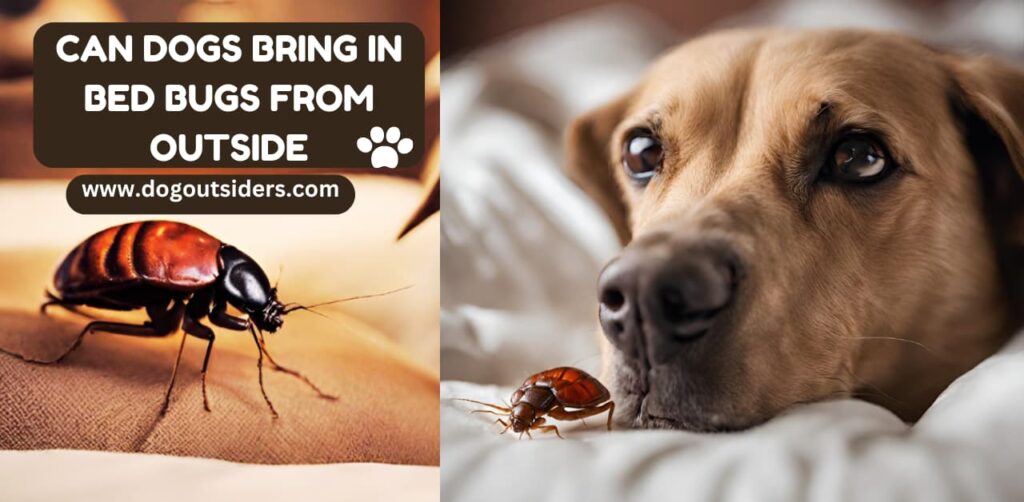“Can dogs bring in bed bugs from outside“? Yes, it’s true! These sneaky pests can latch onto your dog’s fur while they explore the great outdoors, unknowingly bringing them inside. Once inside, these unwelcome guests can quickly infest your home, causing sleepless nights and itchy bites. But fear not, there are ways to prevent this scenario from becoming a reality.
Understanding Bed Bug Nature
Hitchhiking Behavior
Bed bugs, small reddish-brown insects, feed on blood and are expert hitchhikers. They can easily hide in cracks, crevices, and even furniture. These pests often latch onto luggage or clothing, making it easy for them to travel unnoticed.
I once unknowingly brought bed bugs into my home after staying at a hotel. The infestation quickly spread, highlighting the importance of being vigilant when traveling.
Nocturnal Activity and Survival
Active mainly at night, bed bugs emerge from their hiding spots to feed on unsuspecting hosts. Their nocturnal nature makes them challenging to detect during the day. These resilient pests can survive for months without feeding, adding to the difficulty of eradicating them.
Keeping my bedroom clutter-free helped me identify a bed bug infestation early on. This proactive approach saved me from a full-blown infestation and costly extermination services.
Can dogs have bed bugs?
Transportation by Dogs
Dogs can inadvertently carry bed bugs into homes, especially through infested pet bedding or other items they encounter. These pesky insects can hitch a ride on dogs, hiding in their fur and potentially spreading to various areas within the house.
Role of Dogs as Carriers
While it’s uncommon for dogs to be primary hosts for bed bugs, they can serve as carriers, moving the pests from one location to another. This transportation role increases the chances of infestations in different parts of the house, posing a challenge for eradication efforts.
Can Pets Spread Bed Bugs?
Unlikely Transmission
Pets, such as dogs, are unlikely to bring bed bugs into your home. These parasites do not typically latch onto animals for transportation. Bed bugs prefer human hosts and are not known to infest pets for travel.
Transportation Methods
Bed bugs are more likely to spread through items like luggage or furniture rather than pets. These pests can hitch a ride on your belongings after you’ve been in an infested area. It’s crucial to inspect and clean your items thoroughly when returning from a trip.

Detecting Bed Bugs on Dogs
Signs to Look For
Inspect your dog for bites, redness, or itching—common signs of bed bug presence on pets. Check their bedding and resting areas for any unusual marks or spots.
If you notice any suspicious symptoms, promptly consult a veterinarian for professional advice and treatment. Early detection is crucial in preventing the spread of bed bugs.
Bedding and Resting Areas
Regularly wash your dog’s bedding in hot water to eliminate any potential bed bugs. Vacuum their resting areas frequently, paying close attention to corners and crevices where bed bugs may hide.
To further protect your home from infestations, consider using pet-safe bed bug repellents in your dog’s living spaces.
Can Bed Bugs Hurt My Pets?
Bed Bug Infestation in Pets
Bed bugs primarily feed on humans, not pets, as they are attracted to human body heat and carbon dioxide. While bed bugs can bite pets, they do not infest them like they do with humans. If your pet is bitten by a bed bug, it may cause discomfort and itching.
Pets such as dogs can carry bed bugs into your home from outside. However, these bugs usually do not stay on pets for long periods as they prefer human hosts. It’s important to regularly check your pets for any signs of bed bug bites or infestation. Monitor their behavior for any unusual scratching or restlessness.
Health Risks for Pets
Although bed bugs biting pets can cause irritation and discomfort, these bites typically do not pose a significant health risk to animals. Unlike fleas or ticks, bed bugs do not transmit diseases to pets through their bites. If you suspect that your pet has been bitten by bed bugs, consult a veterinarian for appropriate treatment.
When dealing with potential bed bug infestations in your home, it’s essential to consider the well-being of your pets. While the focus is often on eradicating these pests from living spaces, ensuring that your pets are comfortable and free from bites is equally important. By taking preventive measures and addressing any signs of infestation promptly, you can protect both your family and furry companions from the nuisance of bed bugs.
Removing Bed Bugs from Dogs
Bathing with Vet-Approved Shampoo
Bathe your dog with a vet-approved shampoo to eliminate any bed bugs that may be hiding in its fur. Focus on lathering the shampoo thoroughly to ensure all areas are covered. Rinse your dog completely to remove any remaining bugs or eggs.
Using a fine-tooth comb, check for and remove any bed bugs or eggs present in your dog’s fur. Start from the head and work your way down, paying close attention to areas like ears, underbelly, and tail. Repeat this process regularly to prevent reinfestation.
Washing Bedding and Toys
Wash your dog’s bedding and toys in hot water to eradicate any bed bugs that might have infested them. High temperatures are effective in killing both bugs and their eggs, ensuring a thorough clean. Dry these items on high heat as an additional precaution.
When dealing with bed bug infestations on pets, it is essential to act promptly to prevent the spread of these pests within your home. By following these steps diligently, you can effectively rid your dog of bed bugs and create a safe environment for both your pet and family.
Personal Experience:
I found that maintaining a regular grooming routine for my dog not only keeps its coat healthy but also helps in detecting any signs of pest infestations early on. This proactive approach has been crucial in addressing issues promptly before they escalate.
Remember that prevention is key when it comes to dealing with bed bugs on pets. Regularly cleaning your pet’s living spaces, such as bedding and toys, can significantly reduce the risk of infestations. Seeking guidance from a veterinarian can provide tailored solutions for your specific situation.
Dog Bed Bug Treatment
Consult Veterinarian
When dealing with pet bedding infested with bed bugs, it’s essential to consult a veterinarian for guidance. They can recommend appropriate treatment options based on your dog’s health condition. Pet-safe bed bug sprays or powders may be suggested to eliminate bed bugs from your pet’s living areas.
I once faced a similar situation when my dog brought in bed bugs from outside. Consulting the vet helped me understand the severity of the issue and find the most effective treatment.
Clean Living Areas
To prevent reinfestation, it’s crucial to maintain cleanliness in your home. Regularly vacuuming and cleaning your house can help eliminate any remaining bed bugs that might have spread from your dog’s bedding. By keeping your living areas tidy, you reduce the risk of bed bugs returning to your pet’s environment.
I found that establishing a routine cleaning schedule not only kept my home free from pests but also ensured my dog’s well-being.
Use Pet-Safe Products
When treating pet bedding for bed bugs, always opt for pet-safe products to ensure the safety of your furry friend. These products are specifically formulated to eliminate pests without posing any harm to pets. Follow the instructions carefully when applying these treatments to avoid any adverse effects on your dog.
I learned the importance of using pet-safe products firsthand when I mistakenly used a harmful spray that caused discomfort to my dog. It’s crucial to prioritize their well-being when choosing treatment options.
Ensuring Dog and Home Safety

Clutter-Free Environment
Maintaining a clutter-free home is crucial to reduce hiding spots for bed bugs. These pests thrive in cluttered areas, making it essential to keep your living space tidy. Regularly decluttering and organizing can significantly minimize the chances of bed bug infestations.
Inspecting your dog’s belongings is equally important. Regularly check their bedding, toys, and crates for any signs of bed bugs. By staying vigilant and addressing any issues promptly, you can prevent these pests from spreading throughout your home.
Sealing Cracks and Crevices
Implementing preventive measures such as sealing cracks and crevices is vital in keeping bed bugs away from your dog. Bed bugs can hide in various tiny spaces, so sealing off potential entry points is essential. Use caulk to seal cracks in walls, floors, and furniture to create a barrier against these pests.
When dealing with bed bugs, it’s crucial to act swiftly and efficiently. If you suspect an infestation, contact a professional pest control service immediately. Seeking professional help can ensure thorough eradication of bed bugs from your home, protecting both your family and pets.
Conclusion:
After exploring the connection between dogs and bed bugs, it’s clear that pets can indeed carry these pesky critters into our homes. Detecting and treating bed bugs on dogs is essential to prevent infestations. Ensuring both pet and home safety is crucial in dealing with this issue effectively.
Regular checks for bed bugs on your furry friends can save you from a potential headache down the line. Keep your living space clean and hygienic, and don’t hesitate to consult a professional if needed. By staying vigilant and taking proactive measures, you can protect your pets and yourself from the nuisance of bed bugs.
FAQ’s:
Yes, dogs can carry bed bugs into your home if they come into contact with infested areas outdoors. Bed bugs may hitch a ride on your pet’s fur or belongings and then spread inside.
Check your dog’s fur for signs of bed bugs like bites, red welts, or small bloodstains. Look for live bugs, eggs, or molted skins. Consult a veterinarian if you suspect an infestation.
While bed bugs primarily feed on human blood, they may also bite pets. Infestations can cause discomfort and skin irritation to animals. Prompt treatment is necessary to protect your pets.
Consult a veterinarian for safe and effective treatments to remove bed bugs from your dog’s fur and skin. Avoid using products not specifically designed for pet use to prevent harm.
Yes, thoroughly clean and treat your dog’s bedding if you suspect bed bug infestation. Wash bedding in hot water and dry on high heat to kill any potential pests.
Regularly inspect your home for signs of bed bugs, keep your dog clean, and maintain a clean living environment. Seek professional pest control help if needed to eliminate infestations effectively.







7 Comments